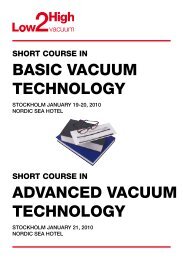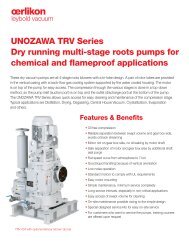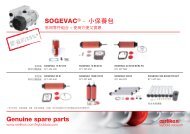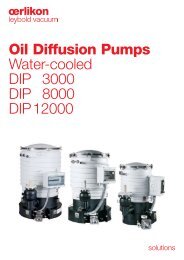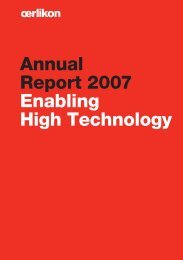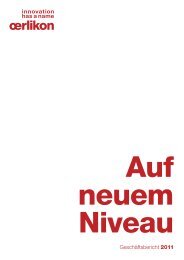Annual Report 2011 (5.07 MB, PDF-File) - Oerlikon
Annual Report 2011 (5.07 MB, PDF-File) - Oerlikon
Annual Report 2011 (5.07 MB, PDF-File) - Oerlikon
You also want an ePaper? Increase the reach of your titles
YUMPU automatically turns print PDFs into web optimized ePapers that Google loves.
Output improved<br />
by 30 %<br />
“For a long time, we underestimated the link between teamwork<br />
and improved performance,” says Wolfgang Ehrk, Head<br />
of Operations at <strong>Oerlikon</strong> Leybold Vacuum. Ehrk considers the<br />
systematic involvement of skilled production workers as the<br />
basis for successful continuous improvement and increased<br />
profitability. The idea: If employees are given the opportunity to<br />
identify workplace improvements, they will then take ownership<br />
of execution.<br />
By engaging employees in this way, the teams in some areas<br />
improved their manufacturing output by 30 % within nine<br />
months. “Of course, it took a number of individual steps to get<br />
us there, but the fact that this success will have such a longrange<br />
impact and was so measurable can be directly attributed<br />
to our team approach.”<br />
For instance, the demand for turbo-molecular pumps – premium<br />
pumps that create high pressure – is growing, and <strong>Oerlikon</strong><br />
Vacuum wanted to not only produce more pumps, but also<br />
integrate new products into the production process. The company<br />
sought to double production output within two years, but<br />
without expanding the physical plant. This meant that the size<br />
of the current assembly lines had to be dramatically reduced.<br />
Together with Ishan Roth and Norbert Tollas, who are responsible<br />
for production at the Cologne site, the employees responded<br />
to this challenge and launched a team project in<br />
which the assembly employees themselves decided how best<br />
to shrink the footprint of production lines. “No one knows the<br />
production floor better than our employees,” Roth says.<br />
Teamwork as a value-creation process<br />
The six-member assembly line team considered a variety of<br />
possible layouts, concentrating on which tools and machines<br />
could be eliminated. The team created a set of practical action<br />
plans, submitted them to Ishan Roth and Sebastian Boll,<br />
<strong>Oerlikon</strong> Leybold’s coordinator for teamwork, and subsequently<br />
executed the plans. Well-known workplace organization<br />
methodologies from the Japanese automotive industry were<br />
employed in this process.<br />
The team, who designed their workplaces themselves, reduced<br />
the amount of space required by the line, succeeded in optimizing<br />
the flow of materials, shortened distances and, most impor-<br />
Employees took over ownership executing improvement measures.




